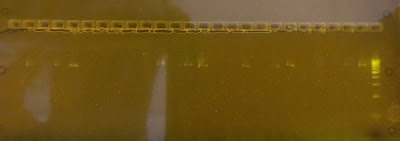That bright band
Once again, I found myself standing next to my grad student as we both stared at set of ambiguous results. The feeling was getting old.
“Is that a primer dimer, or a second locus?” I mused out loud.
“Well, there’s nothing in the negative control,” Kharis replied. At least that was good news - our samples were free of contamination.
“The DNA ladder is super scrunched up - I can’t tell now long that fragment is,” I commented. If only Hanny were here. She would know what to say.
If “eureka” moments exist in science, I have certainly never had one. The process of discovering how the world works is slow. Many days, it feels to me like trudging through a bog, trying desperately to free a boot from the mud and take a step forward before the other one sinks in. There is no sprinting in my world, no sudden flashes of brilliance. There is just soggy ground and sinking boots and an electrophoresis gel with frustrating, ambiguous patterns.
We decided to send the samples for sequencing and see what we got. If at least some of them worked, it would mean we could move forward with the real samples (yes, this frustrating lot was still just the test samples). Two sequences came back with reasonable matches, so we called that a win. Does our method work? Well, technically yes, but definitely not for everything. And that will have to be good enough for now.
For anyone reading this who has genetic experience: we’re trying to optimize PCR protocols for sequencing the COI locus in invertebrate larvae. I bet I had your sympathy as soon as you read the words “optimize PCR,” didn't I?
 |
| Our electrophoresis gel. Each band represents a PCR that worked - there are some real successes on there! The big bright smear on the right is the DNA ladder. |
Comments
Post a Comment